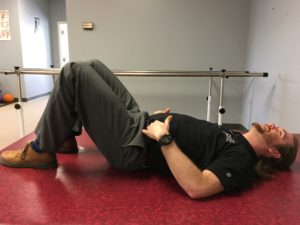Low back pain is one of the most common ailments that people experience at some point in their life. According to the American Physical Therapy Association, about 2/3 of Americans suffer from back pain that effects their ability to perform everyday tasks such as work, exercise, and sleep.
Of those who are affected by back pain, 72% say they use medication for pain relief and 55% use ice or hot packs for pain relief. Recently, there has been a push for physical therapy as an alternative to pain medication due to the increase in opiate addiction. For me personally, I don’t really like how some pain medications make me feel groggy and loopy. Besides that, medication is only masking the pain and not addressing the underlying issue. Physical therapy is a great alternative that not only makes you feel better, but also addresses what is really causing your pain in the first place.
Related: Why Back Pain is So Common
While back pain can affect your everyday life, there are ways to decrease and prevent the pain from occurring. While some back pain is caused by more serious conditions such as osteoarthritis or a herniated disc, most of the time it is not that serious and can be effectively treated with manual therapy and exercise. This is where physical therapy comes in.
I want to talk to you about 2 muscles that help to stabilize the low back (lumbar spine).
First, is the Transverse Abdominis (TA).
The TA is the deepest abdominal muscle in our core. It wraps around the abdomen between the lower ribs and the top of the pelvis, functioning like a corset. The TA stabilizes the low back and pelvis before movement of the legs and arms occurs. This is an important muscle for people with degenerative joint issues. To strengthen the Transverse Abdominis, try the TA Brace exercise.
Setup: Begin lying on your back with your knees bent, feet resting on the floor, and your fingers resting on your stomach just above your hip bones.
Movement: Tighten your abdominals, pulling your navel in toward your spine and up, as if putting on a tight pair of pants. You should feel your transverse abdominis contract under your fingers. Hold this position 5-10 seconds, then relax and repeat.
Tip: Make sure to keep the natural arch in your low back. Do not flatten back against the floor and do not hold your breath as you tighten your muscles.
Second, is the Multifidus muscle(s).
The multifidus is a short muscle that connects each vertebra along the entire spine on both sides. This muscle, along with the TA, helps to stabilize the spine before arm and leg movements occur. Once your low back pain has gone away, it’s important to keep strengthening the Multifidus to help prevent a reoccurrence of pain from happening again. To strengthen this muscle, try the Multifidus Isometric Hold.
Setup: Begin lying on your back with one leg bent with foot on the floor and the other leg straight with a towel roll below your heel.
Movement: Tighten your abdominals and gently press the heel of your straight leg down into the towel. Hold for 3-5 seconds, repeat 20 repetitions.
Tip: Make sure to keep your back flat against the mat. There should be little to no movement in the back or pelvis with this exercise.
Related: How Physical Therapy Treats Back Pain
If you have been experiencing back pain for 3-4 days without any relief or if the pain is increasing, get in to see your healthcare professional for a full examination. We offer FREE 30 minute pain consultations at Back in Motion® where a physical therapist can take a look you and determine if physical therapy is something that you could benefit from. Don’t let back pain get in the way of your life; take the steps needed to live pain free. Don’t wait, call today!





 By Andy Broomhall
By Andy Broomhall